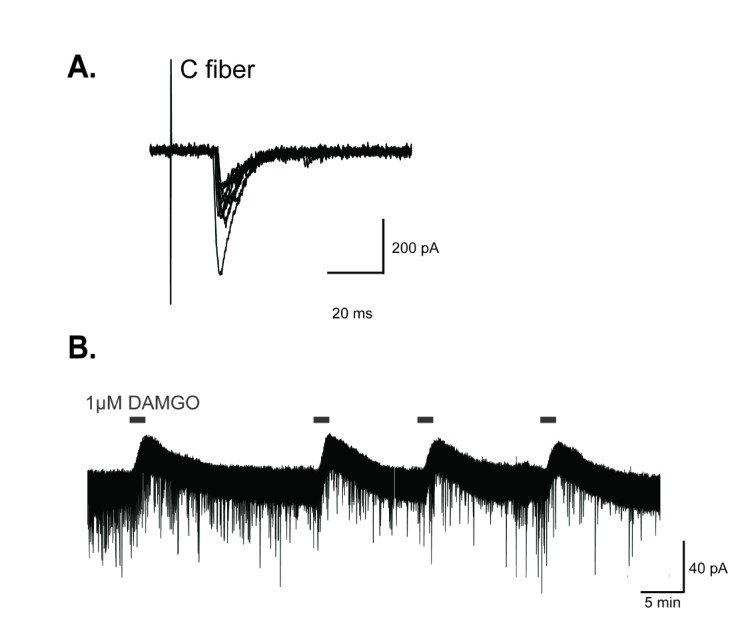INTRODUCTION
METHODS
Animals
Slice preparation
Electrophysiology recording
Drugs
Statistics
RESULTS
Monosynaptic transmission between primary nociceptive C fibers and GABAergic interneurons was successfully verified by attached-dorsal root stimulation
 | Fig. 1DAMGO, a selective µ-opioid receptor agonist, produced outward currents in GABAergic interneurons of the SG.(A) Identification of monosynaptic inputs from primary nociceptive C fibers to GABAergic interneurons. Superimposition traces of evoked EPSCs induced by monosynaptic C fiber inputs to GABAergic interneurons (conduction velocity (CV)=0.3 m/s). (B) In voltage clamp mode, DAMGO produced reproducible outward currents of about 39.55±2.16 pA in GABAergic interneurons. Holding potential (VH)=−70 mV.
|
DAMGO, a selective µ-opioid receptor agonist, reduced the excitability of GABAergic interneurons in SG
DAMGO-induced current is mediated by K+ channels
 | Fig. 2DAMGO-induced current is mediated by K+ channels.(A) Representative traces of current responses in the absence and presence of DAMGO in GABAergic interneurons. Voltage steps of 500 ms durations were commanded from −120 mV to −30 mV with 10 mV steps before and during superfusion with DAMGO. Holding potential (VH)=−70 mV. (B) The current-voltage (I-V) relationship of the DAMGO-induced current (n=6). (C) Schematic diagram of experimental protocol in (Ca) and representative traces of current responses of GABAergic interneurons (Cb) in the aCSF, DAMGO, and DAMGO added Ba2+. Voltage steps were commanded from −120 mV to −30 mV with 10 mV steps each lasting 500 ms. Holding potential (VH)=−70 mV. The I-V relationship shows that DAMGO-induced current is completely blocked by extracellular Ba2+ (Cc). (n=6, p<0.05, Two-way RM ANOVA).
|
 | Fig. 3DAMGO-induced current is dependent on external K+ concentrations.(A) Representative traces of current responses at normal (2.5 mM) and high (8.5 mM) concentrations of the external K+ during DAMGO treatment. Voltage steps of 500 ms durations were commanded from −120 mV to −30 mV with 10 mV steps. (B) The DAMGO-induced current significantly increased at high K+ concentrations (n=5, p<0.05, Two-way RM ANOVA). Holding potential (VH)=−70 mV.
|
DAMGO reduced excitatory synaptic transmission between primary nociceptive C fibers and GABAergic interneurons in SG
 | Fig. 4DAMGO affects excitatory synaptic transmission between primary nociceptive C fibers and GABAergic interneurons in SG.(A) Representative traces before, during, and after DAMGO treatment. (B) Evoked EPSCs were significantly decreased by DAMGO in GABAergic interneurons which receive monosynaptic nociceptive input from C fibers. The evoked EPSCs were decreased to 42.24±10.41% of baseline and recovered by 9.92±7.02 of baseline (n=12; p<0.01, paired t-test). Data are presented as mean±SEM.
|
DISCUSSION
 | Fig. 5A diagram to illustrate a possible mechanism by which DAMGO works in the SG.(A) In spinal dorsal horn, excitatory neurons normally receive an inhibitory control of GABAergic interneurons, and as a result, pain transmission is properly modulated. In addition, these GABAergic interneurons inhibit each other. (B) Under DAMGO, the excitability of GABAergic interneurons which receive direct excitatory inputs from primary nociceptive C fibers is decreased. If so, the inhibition of another GABAergic interneurons (*) toward excitatory neurons can be enhanced. As a results, the sum of excitation of the entire spinal circuit will reduce the pain transmission.
|




 PDF
PDF ePub
ePub Citation
Citation Print
Print


 XML Download
XML Download